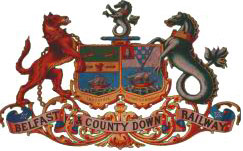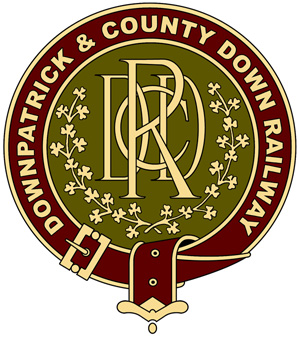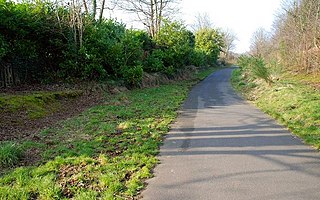
The Belfast and County Down Railway (BCDR) was an Irish gauge railway in Ireland linking Belfast with County Down. It was built in the 19th century and absorbed into the Ulster Transport Authority in 1948. All but the line between Belfast and Bangor was closed in the 1950s, although some of it has been restored near Downpatrick by a heritage line, the Downpatrick and County Down Railway.

The Downpatrick and County Down Railway (DCDR) is a 5 foot, 3 inch gauge heritage railway in County Down, Northern Ireland. It is operated by volunteers and runs passenger trains using steam and diesel locomotives, diesel railcars, and vintage carriages. The railway has approximately three miles (4.8 km) of track in a triangular-shaped layout, which connects the town of Downpatrick with the historical sites of Inch Abbey to the north and King Magnus’ Grave to the south. It also houses a museum of railway artefacts and rolling stock originating from both Northern Ireland and the Republic of Ireland, dating from the 1860s to the 1980s.

Ballymacarrett or Ballymacarret is the name of both a townland and electoral ward in Belfast, Northern Ireland. The townland is in the civil parish of Knockbreda in the historic barony of Castlereagh Upper in County Down, and has existed since earlier than 1622.

The Great Northern Railway (Ireland) (GNR(I) or GNRI) was an Irish gauge (1,600 mm (5 ft 3 in)) railway company in Ireland. It was formed in 1876 by a merger of the Irish North Western Railway (INW), Northern Railway of Ireland, and Ulster Railway. The governments of Ireland and Northern Ireland jointly nationalised the company in 1953, and the company was liquidated in 1958: assets were split on national lines between the Ulster Transport Authority and Córas Iompair Éireann.

The Dublin-Belfast Line or The Great Northern Main Line(Dublin line by NI Railways and Belfast line by Irish Rail) is a 112-mile semi-electrified railway connecting Belfast Grand Central in Northern Ireland to Dublin Connolly in the Republic of Ireland. The key towns and cities of Skerries, Drogheda, Dundalk, Newry, Portadown, Lurgan, and Lisburn are situated along the line. The Dublin-Belfast Line is the busiest railway route on the island of Ireland, carrying a mixture of intercity rail, regional rail, commuter rail traffic and freight traffic. It is uniquely significant as the only railway line that crosses the Republic of Ireland–United Kingdom border.

Titanic Quarter railway station is located in the townland of Ballymacarrett in east Belfast, Northern Ireland. It is a short walk from the SSE Arena and Titanic Quarter.

The Lisburn–Antrim line is a 20-mile (32 km) railway line of Northern Ireland Railways. It links Knockmore Junction on the Belfast–Newry line with Antrim on the Belfast–Derry line. It has been closed to passenger services since 2003.

Frankford Junction is a railroad junction, and former junction station, located on the border between the Harrowgate neighborhood of Philadelphia and Frankford, Philadelphia. At the junction, the 4-track Northeast Corridor line from Trenton connects with the 2-track Atlantic City Line from Atlantic City in the northeastern portion of Philadelphia about 2.9 miles (4.7 km) northeast of North Philadelphia station. It lies near the intersection of Frankford Avenue and Butler Street, to the west of the interchange between Interstate 95 and the approach to the Betsy Ross Bridge. It has been used for rail transportation since 1832 but has not served as a station since October 4, 1992.

Neill's Hill railway station is a disused railway station / halt on the main line of the Belfast and County Down Railway. It ran from Queen's Quay, Belfast south to Newcastle, County Down in Northern Ireland.

Ballymacarrett railway station was a railway halt that served the townland of Ballymacarrett in east Belfast.

Queen's Quay railway station served the east of Belfast in Northern Ireland. It was formerly one of the three terminus railway stations in Belfast. The others were Great Victoria Street, and York Road.

Glider is a Bus rapid transit system in Belfast, Northern Ireland, designed to improve the efficiency of mass transit in the city by connecting East and West Belfast and the Titanic Quarter via the city centre. The service is operated by Translink.
Harda railway station is a major railway station in Harda district, Madhya Pradesh. Its code is HD. It serves Harda city. The station consists of four platforms, all well sheltered. It has facilities including water and sanitation.
The Ballymacarrett rail crash occurred on 10 January 1945 at 7:50am in the Ballymacarrett area of Belfast, County Down, Northern Ireland on the Belfast to Bangor Line of the Belfast and County Down Railway, when a train led by a heavy autotrain driving trailer ran into the back of a stopped passenger train consisting of lightweight wooden coaches. 22 died with 27 injured. It was the worst crash in Northern Ireland since 1889. The cause was found to be carelessness of the driver of the autotrain who was running too fast for conditions. Fog, unsafe railway rules, and possible distraction from passengers all may have contributed to the accident. Old lightweight rolling stock contributed to the great number of injuries and deaths. The accident led to the demise of the railway company which was nationalised three years later.
Ballymacarrett Junction was a railway switching point on the Belfast and County Down Railway in the Ballymacarrett area of Eastern Belfast, in modern-day Northern Ireland. It was located near the present-day Titanic Quarter railway station.
Windsor railway station was on the Belfast Central Railway which ran from Ulster Junction on the Ulster Railway to Ballymacarrett Junction on the Belfast and County Down Railway, through central Belfast, Ireland.
Ormeau railway station was on the Belfast Central Railway which ran from the Ulster Junction on the Ulster Railway to Ballymacarrett Junction on the Belfast and County Down Railway, through central Belfast, Ireland.
Queen's Bridge railway station was the terminus of the Belfast Central Railway which ran from the Ulster Junction on the Ulster Railway and later Great Northern Railway (Ireland) to Ballymacarrett Junction on the Belfast and County Down Railway, through central Belfast, Ireland.

The Belfast Central Railway (BCR) was a railway company operating in Belfast, Northern Ireland. The company was incorporated by the Belfast Central Railway Act 1872 and acquired by the Great Northern Railway (Ireland) in 1885.












